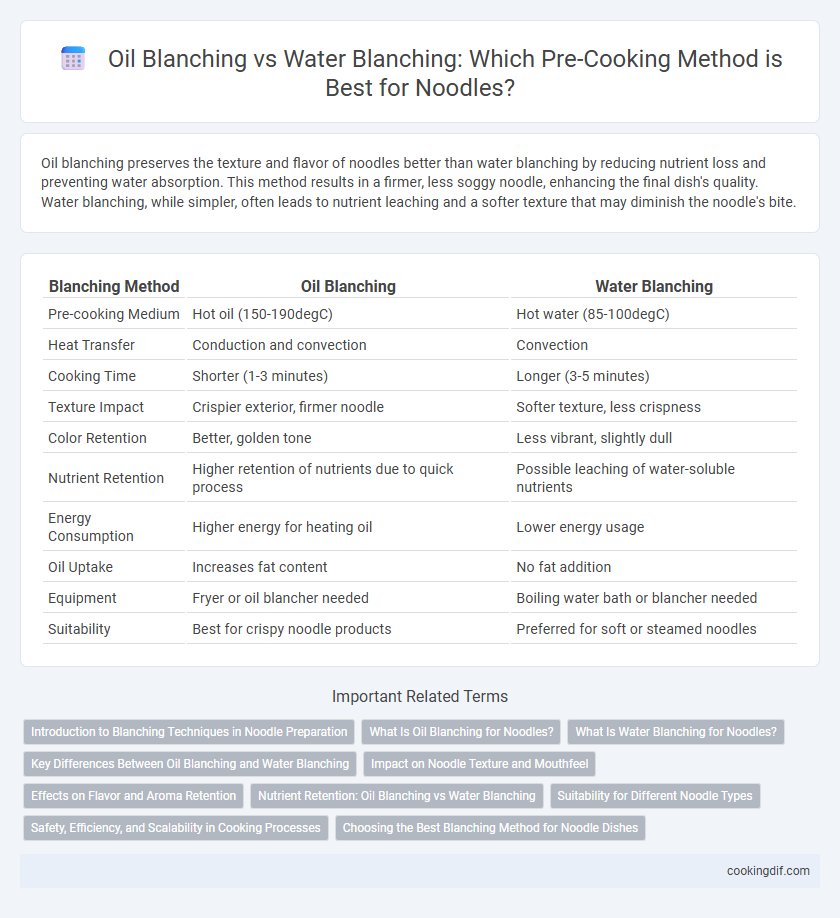Oil blanching preserves the texture and flavor of noodles better than water blanching by reducing nutrient loss and preventing water absorption. This method results in a firmer, less soggy noodle, enhancing the final dish's quality. Water blanching, while simpler, often leads to nutrient leaching and a softer texture that may diminish the noodle's bite.
Table of Comparison
| Blanching Method | Oil Blanching | Water Blanching |
|---|---|---|
| Pre-cooking Medium | Hot oil (150-190degC) | Hot water (85-100degC) |
| Heat Transfer | Conduction and convection | Convection |
| Cooking Time | Shorter (1-3 minutes) | Longer (3-5 minutes) |
| Texture Impact | Crispier exterior, firmer noodle | Softer texture, less crispness |
| Color Retention | Better, golden tone | Less vibrant, slightly dull |
| Nutrient Retention | Higher retention of nutrients due to quick process | Possible leaching of water-soluble nutrients |
| Energy Consumption | Higher energy for heating oil | Lower energy usage |
| Oil Uptake | Increases fat content | No fat addition |
| Equipment | Fryer or oil blancher needed | Boiling water bath or blancher needed |
| Suitability | Best for crispy noodle products | Preferred for soft or steamed noodles |
Introduction to Blanching Techniques in Noodle Preparation
Oil blanching enhances noodle texture by rapidly sealing the surface, preserving flavor and reducing moisture loss, while water blanching softens noodles uniformly through heat absorption, aiding in starch gelatinization and enzyme inactivation. The choice between oil and water blanching impacts noodle shelf life and mouthfeel, with oil blanching providing a slightly crisper bite and water blanching ensuring consistent hydration. Understanding these methods allows producers to tailor noodle quality to specific culinary applications and consumer preferences.
What Is Oil Blanching for Noodles?
Oil blanching for noodles involves briefly immersing them in hot oil to partially cook and partially dehydrate the pasta, enhancing texture and reducing cooking time in the final preparation. This method creates a firmer, non-sticky noodle surface by sealing starch granules, compared to water blanching, which softens the noodles more and can lead to nutrient leaching. Oil blanching is particularly effective for instant noodles production, providing improved shelf life and better mouthfeel.
What Is Water Blanching for Noodles?
Water blanching for noodles involves briefly immersing them in boiling water to partially cook and soften the texture while preserving their color and nutrient content. This method helps remove surface starch, preventing stickiness and improving cooking consistency. Water blanching is energy-efficient and widely used in industrial noodle production for maintaining product quality before final cooking or freezing.
Key Differences Between Oil Blanching and Water Blanching
Oil blanching involves submerging noodles in hot oil, resulting in faster heat transfer, enhanced flavor, and a crispy texture, while water blanching uses boiling water to soften noodles, preserving moisture and reducing oil content. Oil blanching typically yields a higher retention of soluble nutrients but may increase fat content, whereas water blanching lowers the risk of oxidative degradation and is preferred for lower-calorie products. The choice between oil and water blanching impacts noodle quality, cooking time, and nutritional profile, making it critical for manufacturers targeting specific texture and health attributes.
Impact on Noodle Texture and Mouthfeel
Oil blanching enhances noodle texture by creating a firmer, chewier bite and preventing surface stickiness, resulting in a smoother mouthfeel compared to water blanching. Water blanching tends to soften noodles more, leading to a less resilient texture and a slightly mushier mouthfeel. The lipid coating from oil blanching also helps retain moisture internally, improving overall noodle elasticity and consumer satisfaction.
Effects on Flavor and Aroma Retention
Oil blanching enhances flavor and aroma retention in noodles by sealing in natural oils and volatile compounds, resulting in a richer taste profile. Water blanching often leads to the leaching of flavor and aroma compounds, causing a milder noodle taste. Consequently, oil blanching is preferred for preserving the authentic sensory qualities of pre-cooked noodles.
Nutrient Retention: Oil Blanching vs Water Blanching
Oil blanching preserves more vitamins such as vitamin A and vitamin C in noodles compared to water blanching, due to reduced leaching of water-soluble nutrients. Water blanching often causes significant nutrient loss as essential minerals and vitamins dissolve into the blanching water. Oil blanching also helps retain the natural texture and flavor of noodles by minimizing nutrient degradation during pre-cooking.
Suitability for Different Noodle Types
Oil blanching suits fried and crispy noodle varieties by preserving texture and preventing sogginess, while water blanching is ideal for softer, boiled noodles, enhancing tenderness and moisture absorption. For instant noodles, oil blanching helps maintain a firm bite, whereas fresh egg noodles benefit from water blanching to retain elasticity and prevent oiliness. The choice between oil and water blanching significantly impacts noodle quality depending on the noodle's intended cooking method and final texture preference.
Safety, Efficiency, and Scalability in Cooking Processes
Oil blanching offers enhanced safety by reducing microbial contamination through high-temperature oil immersion, while water blanching may require more stringent temperature controls to prevent pathogen survival. Efficiency in oil blanching is marked by faster heat transfer and shorter processing times, contrasted with slower heat penetration and higher energy consumption in water blanching. Scalability favors oil blanching in continuous cooking lines due to consistent temperature maintenance and reduced water disposal issues, whereas water blanching demands larger sanitation systems and increased water usage at scale.
Choosing the Best Blanching Method for Noodle Dishes
Oil blanching preserves noodle texture and enhances flavor by creating a light, crispy exterior, ideal for stir-fry dishes requiring a firm bite. Water blanching effectively softens noodles while removing excess starch, ensuring even cooking and ideal moisture retention for soups and broths. Selecting between oil and water blanching depends on the desired noodle texture and the cooking method, optimizing dish quality and taste.
Oil blanching vs water blanching for pre-cooking Infographic

 cookingdif.com
cookingdif.com